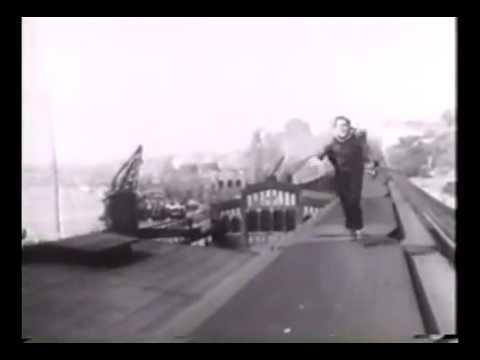Parkour is a training discipline using movement that developed from military obstacle course training.Parkour was developed in France, primarily by Raymond Belle, and further by his son David Belle and his group of friends, the self-styled Yamakasi, during the late 1980s.The discipline was popularized in the late 1990s and 2000s through films, documentaries, and advertisements featuring the Yamakasi.
This video below depicts some cool parkour from the 1930s.
https://youtu.be/MX4IXndCoIM
In Western Europe, a forerunner of parkour was French naval officer Georges Hébert, who before World War I promoted athletic skill based on the models of indigenous tribes he had met in Africa. He noted, “their bodies were splendid, flexible, nimble, skillful, enduring, and resistant but yet they had no other tutor in gymnastics but their lives in nature.”His rescue efforts during the 1902 eruption of Mount Pelée on Saint-Pierre, Martinique, reinforced his belief that athletic skill must be combined with courage and altruism. Hébert became a physical education tutor at the college of Reims in France.
Hébert set up a “méthode naturelle” (natural method) session consisting of ten fundamental groups: walking, running, jumping, quadrupedal movement, climbing, balancing, throwing, lifting, self-defense, swimming. These were intended to develop “the three main forces”: energetic (willpower, courage, coolness, and firmness), moral (benevolence, assistance, honor, and honesty) and physical (muscles and breath).During World War I and World War II teaching continued to expand, becoming the standard system of French military education and training. Inspired by Hébert, a Swiss architect developed a “parcours du combattant“—military obstacle course—the first of the courses that are now standard in military training and which led to the development of civilian fitness trails and confidence course.
According to Williams Belle, the philosophies and theories behind parkour are an integral aspect of the art, one that many non-practitioners have never been exposed to. Belle trains people because he wants “it to be alive” and for “people to use it”. Châu Belle explains it is a “type of freedom” or “kind of expression”; that parkour is “only a state of mind” rather than a set of actions, and that it is about overcoming and adapting to mental and emotional obstacles as well as physical barriers.
A newer convention of parkour philosophy has been the idea of “human reclamation”. Andy (Animus of Parkour North America) clarifies it as “a means of reclaiming what it means to be a human being. It teaches us to move using the natural methods that we should have learned from infancy. It teaches us to touch the world and interact with it, instead of being sheltered by it.” “It is as much as a part of truly learning the physical art as well as being able to master the movements, it gives you the ability to overcome your fears and pains and reapply this to life as you must be able to control your mind in order to master the art of parkour.”
Academic research on parkour has tended to describe how parkour provides a novel way of interacting with the (urban) environment, that challenges the use and meaning of urban space, metropolitan life, and embodiment.
Traceur Dylan Baker says “Parkour also influences one’s thought processes by enhancing self-confidence and critical thinking skills that allow one to overcome everyday physical and mental obstacles”
